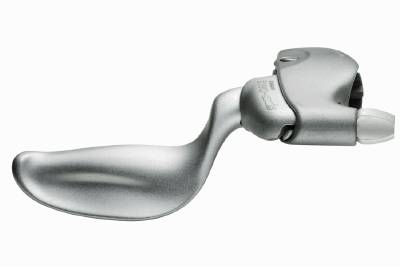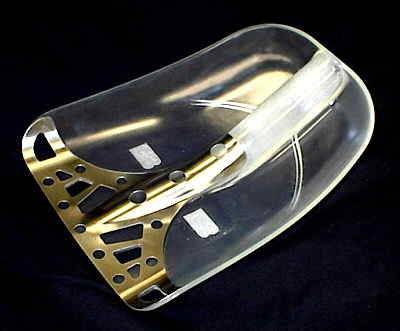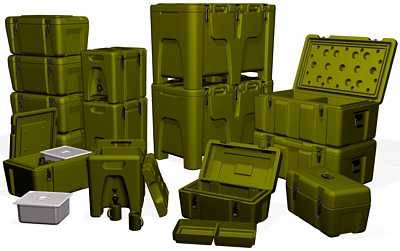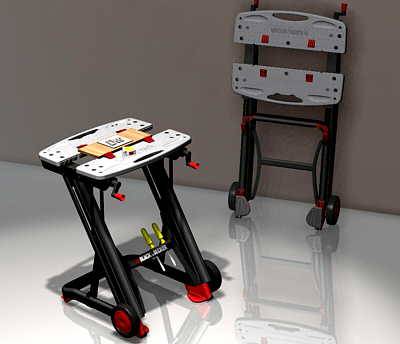 Look at the way it’s always been done and then break all the rules. That’s how SRAM® Corporation, a bicycle parts manufacturer headquartered in Chicago, came up with the award winning Two-AxisTM brake lever. It doesn’t just pull straight back from the handlebar like the brakes on those other bikes you’ve ridden. Instead, the lever follows the natural motion of the bicyclist’s hand – sweeping down and back at the same time.
Look at the way it’s always been done and then break all the rules. That’s how SRAM® Corporation, a bicycle parts manufacturer headquartered in Chicago, came up with the award winning Two-AxisTM brake lever. It doesn’t just pull straight back from the handlebar like the brakes on those other bikes you’ve ridden. Instead, the lever follows the natural motion of the bicyclist’s hand – sweeping down and back at the same time.
This cylindrical, arc-like motion makes the braking operation more comfortable, less fatiguing and safer. Plus it looks really great. The silver aluminum lever mechanism and metallic-toned composite housing are smooth, sleek and contoured, reflecting a beautiful play of light and shadow. It’s just the thing to pump up your biking style image.
SRAM Takes Lead in Biking Innovation
In recognition of SRAM’s original functional and aesthetic design, ID Magazine recently gave the Two-Axis a Design Distinction Award at its annual consumer product competition. The all-new brake lever has also been awarded a patent and is one of many innovative new SRAM products, including the SparcTM power-assist drivetrain system and the SmartBarTM , a fully integrated handlebar system. These awards and patents attest to SRAM’s role in the mountain and pavement biking industry as innovator and advocate to the sport since 1987.
50 Ways to Check the Lever
 When it comes to the process of product development at SRAM, the Advanced Components Design (ACD) group is usually the first to address a new functional concept. The group starts with physical prototypes which are studied exhaustively to get the best sense of ergonomics. In the case of SRAM’s Two-Axis brake levers, the process took nearly a year.
When it comes to the process of product development at SRAM, the Advanced Components Design (ACD) group is usually the first to address a new functional concept. The group starts with physical prototypes which are studied exhaustively to get the best sense of ergonomics. In the case of SRAM’s Two-Axis brake levers, the process took nearly a year.
Fifty different shapes were crafted and modified along with a soft tooled functional prototype in order to conduct the field testing. One finger and two finger concepts were studied for racing applications, but eventually SRAM focused on the pavement market and went with a four finger paddle. The wider style gives the rider a greater sense of braking security and confidence, while its advanced ergonomics increase comfort.
Higher State of Perfection through Digital Design
Once SRAM’s ACD department has tested out the component geometry and mechanical movement, the design concept is turned over to a multi-discipline product development team. At this point, everything goes digital. Using PRO/Engineer CAD software, the components are analyzed for strength of material and ease of manufacture. As SRAM’s Engineers organize the structural components into a simple, functional assembly, the Industrial Designers are developing the visual and ergonomic end package for these components.
SRAM’s Industrial Design team uses Alias|Wavefront StudioTools 3D modeling software to transform the elementary engineering assembly into a graceful, ergonomic package. It is not until this stage that form and function actually begin to blend into an award-winning object of practical beauty.
The Road to Success is Paved with Collaboration
Kent Solberg, SRAM’s Global Industrial Design Manager, says his group first learned the value of using modeling software five years ago when it installed an early version of StudioTools.
“Industrial design focuses on the overall look and feel of a product, while Engineering cares about strength, dynamics and manufacturing processes,” Solberg emphasizes. “When we put StudioTools and Pro/E together, we are able to resolve and integrate the two disciplines. The control of our designs has become much tighter because we build around exact functional data. As a result, nearly all of SRAM’s products today are externally surfaced in StudioTools.”
 Solberg also finds that SRAM’s digital tools enable their engineering and design departments to start working together much earlier in the process. One group doesn’t have to stop while the other makes changes. “The aesthetics and functional parts are easy to separate so data can be changed while the project keeps moving along,” he explains.
Solberg also finds that SRAM’s digital tools enable their engineering and design departments to start working together much earlier in the process. One group doesn’t have to stop while the other makes changes. “The aesthetics and functional parts are easy to separate so data can be changed while the project keeps moving along,” he explains.
“This ability marks a fundamental change in the approach to industrial design. With software like StudioTools, an industrial designer can create a highly refined form and be assured it respects all engineering requirements. It’s incredibly empowering to know that our vision will make it all the way to the final manufactured product,” Solberg says.
Now That’s How It’s Supposed To Be
While it’s important to receive recognition such as ID Magazine’s Design Distinction Award, the real test of a product’s success lies in consumer acceptance. Recently pavement bike riders throughout the world began wrapping their hands around SRAM’s revolutionary Two-Axis brake levers and the question they are asking is “where have these been all my life?”
Try one out for yourself at your local bicycle dealer and see how digital collaboration between great engineering and great design really does make better products.
Images: Courtesy SRAM Corporation. Sketches and renderings created in Alias|Wavefront StudioTools.








